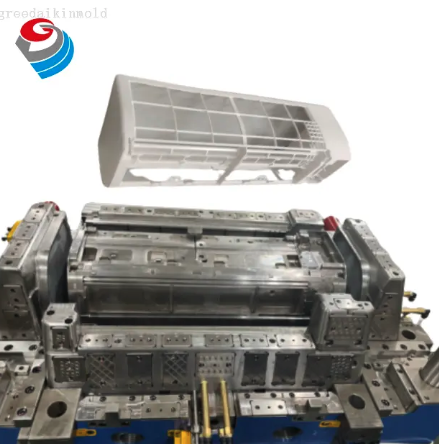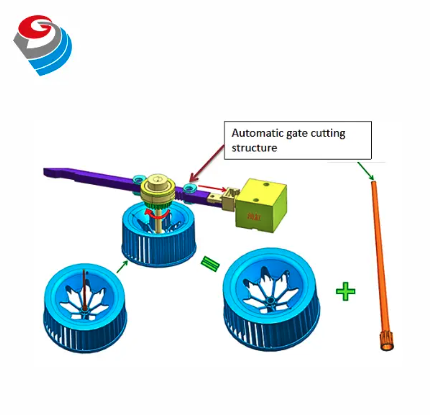Views: 0 Author: Site Editor Publish Time: 2025-07-10 Origin: Site
In the world of precision manufacturing and mold engineering, understanding the mechanical properties of materials is not just a technical necessity—it is the foundation of innovation, reliability, and performance. Among the most critical mechanical properties are tensile strength and yield strength, two terms that are often used interchangeably but represent fundamentally different aspects of material behavior under stress.
For companies like ZHUHAI GREE DAIKIN PRECISION MOLD CO., LTD., a leading Chinese-Japanese joint venture specializing in high-precision molds for automotive, home appliances, and industrial products, the distinction between tensile strength and yield strength is not academic—it is a daily engineering reality. From injection molds that must withstand high-pressure polymer flows to stamping dies that endure repeated mechanical loads, the performance of GreeDaikinMold’s products is directly tied to the mechanical properties of the materials they use and the components they produce. This article explores the fundamentals of tensile strength and yield strength, their relevance in modern manufacturing, and how GreeDaikinMold leverages this knowledge to deliver world-class precision molds and components. We will also examine how these properties influence material selection, product design, and quality assurance in the context of current industry trends such as lightweighting, sustainability, and smart manufacturing.

Tensile strength, also known as ultimate tensile strength (UTS), is the maximum stress a material can withstand while being stretched or pulled before breaking. It is a measure of the material’s resistance to failure under tension. Tensile strength is typically expressed in megapascals (MPa) or pounds per square inch (psi).
In practical terms, tensile strength tells us how much force a material can handle before it fractures. This is especially important in applications where materials are subjected to pulling forces, such as in automotive components, aerospace structures, and industrial machinery.
Tensile strength is determined through a tensile test, where a sample is clamped at both ends and pulled until it breaks. The stress (force per unit area) and strain (deformation) are recorded throughout the test. The highest point on the stress-strain curve is the tensile strength.
Tensile strength is a fundamental property in material selection and engineering design. It provides critical information about a material’s ability to withstand forces that attempt to pull it apart. For example, in the automotive industry, components such as chassis frames, engine mounts, and suspension parts must possess high tensile strength to ensure safety and durability under dynamic loads. Similarly, in aerospace applications, materials with high tensile strength are essential for withstanding the extreme forces experienced during flight.
Several factors can influence a material’s tensile strength, including:
Material Composition: Alloying elements can significantly enhance tensile strength. For instance, adding carbon to iron increases the tensile strength of steel.
Heat Treatment: Processes such as quenching and tempering can improve tensile strength by altering the microstructure of the material.
Manufacturing Processes: Cold working, rolling, and forging can increase tensile strength through work hardening.
Temperature: Generally, tensile strength decreases as temperature increases, making material selection critical for high-temperature applications.
Yield strength is the stress at which a material begins to deform plastically. Before reaching the yield point, the material will deform elastically, meaning it will return to its original shape when the load is removed. Once the yield strength is exceeded, the deformation becomes permanent.
Yield strength is a critical parameter in engineering design because it defines the limit of elastic behavior. For components that must maintain their shape under load—such as molds, dies, and structural parts—yield strength is often more important than tensile strength.
Yield strength is also determined through a tensile test. It is typically identified as the point on the stress-strain curve where the material begins to deviate from linearity (the elastic region). In some materials, especially those without a clear yield point (like aluminum), the 0.2% offset method is used to determine yield strength. This method involves drawing a line parallel to the initial linear portion of the stress-strain curve, offset by 0.2% strain, and finding the intersection point with the curve.
Yield strength is essential for ensuring that components do not undergo permanent deformation during service. For example, in precision molds used by GreeDaikinMold, maintaining dimensional accuracy is crucial. If a mold deforms plastically during operation, it can lead to defective parts, increased scrap rates, and costly downtime. Therefore, selecting materials with adequate yield strength is vital for maintaining product quality and operational efficiency.
Similar to tensile strength, yield strength is influenced by several factors:
Material Composition: Alloying elements can enhance yield strength. For example, adding nickel and chromium to steel increases its yield strength.
Heat Treatment: Processes like annealing, quenching, and tempering can modify yield strength by changing the material’s microstructure.
Cold Working: Plastic deformation at room temperature can increase yield strength through strain hardening.
Grain Size: Finer grain sizes generally result in higher yield strength, as grain boundaries impede dislocation motion.
| Property | Tensile Strength | Yield Strength |
|---|---|---|
| Definition | Maximum stress before fracture | Stress at which plastic deformation begins |
| Material Behavior | Fracture point | Elastic limit |
| Importance in Design | Indicates ultimate failure point | Indicates safe operating limit |
| Measurement Method | Peak of stress-strain curve | Deviation from linearity or 0.2% offset |
| Application Relevance | Critical for safety and failure analysis | Critical for dimensional stability |
The table outlines the key differences between tensile strength and yield strength. Tensile strength refers to the maximum stress a material can withstand before fracturing, marking the point of ultimate failure. In contrast, yield strength is the stress level at which a material begins to deform plastically, indicating the limit of elastic behavior. While tensile strength is crucial for understanding a material’s breaking point and is often used in safety and failure analysis, yield strength is more relevant for design purposes, as it defines the safe operating limit to maintain dimensional stability. Tensile strength is measured at the peak of the stress-strain curve, whereas yield strength is identified by the deviation from linearity or the 0.2% offset method.
At GreeDaikinMold, precision is not just a goal—it is a standard. The company’s molds are used in high-performance applications where even minor deformations can lead to product defects, production downtime, or safety issues. Understanding tensile and yield strength allows GreeDaikinMold engineers to:
Select appropriate materials for molds and components based on expected loads and stresses.
Design molds that maintain dimensional accuracy under repeated thermal and mechanical cycles.
Ensure product longevity by avoiding plastic deformation during operation.
Optimize manufacturing processes to reduce waste and improve efficiency.
For example, in injection mold, the mold must withstand high pressures and temperatures without deforming. A material with insufficient yield strength may warp or distort, leading to defective parts. Similarly, in stamping operations, the die must endure repeated impacts without cracking or yielding.
As industries push for lighter, more fuel-efficient vehicles and aircraft, manufacturers are turning to advanced materials like high-strength aluminum alloys, composites, and ultra-high-strength steels. These materials often have high tensile strength but lower yield strength, requiring careful design to avoid permanent deformation.
GreeDaikinMold supports this trend by developing molds that can process lightweight materials with precision, ensuring that the final components meet strict strength and weight requirements.
Sustainability is no longer optional. Manufacturers are under pressure to reduce waste, energy consumption, and material usage. By understanding yield strength, GreeDaikinMold can design molds that use thinner walls or less material without compromising performance, contributing to more sustainable production processes.
With the rise of Industry 4.0, sensors and data analytics are being used to monitor mold performance in real time. By tracking stress and strain data, engineers can predict when a mold is approaching its yield strength and schedule maintenance before failure occurs. This proactive approach reduces downtime and extends mold life.
In automotive applications, components must withstand high loads and vibrations.GreeDaikinMold uses materials with high tensile and yield strengths to produce molds for engine parts, chassis components, and interior panels. These molds are designed to maintain their shape and performance over millions of cycles.
For home appliances like air conditioners and refrigerators, appearance and dimensional accuracy are critical. GreeDaikinMold selects materials with balanced strength properties to ensure that the molds produce parts with smooth surfaces and tight tolerances.
Industrial products often operate in harsh environments. GreeDaikinMold’s molds are built to resist deformation under extreme conditions, using materials with high yield strength to ensure long-term reliability.

Tensile strength is the maximum stress a material can withstand before breaking, while yield strength is the stress at which a material begins to deform plastically (permanently). Tensile strength indicates the material’s ultimate failure point, whereas yield strength marks the limit of elastic behavior.
In mold manufacturing, especially for precision molds like those produced by GreeDaikinMold, these properties determine how well a mold can withstand mechanical and thermal stresses without deforming or failing. High tensile strength ensures durability, while high yield strength maintains dimensional accuracy during repeated use.
Both properties are measured using a tensile test, where a material sample is stretched until it breaks. Tensile strength is the highest point on the stress-strain curve, while yield strength is identified by the point where the material begins to deform plastically, often using the 0.2% offset method for materials without a clear yield point.
GreeDaikinMold uses high-performance materials such as P20 steel, H13 steel, and S136 stainless steel, which offer excellent tensile and yield strength properties. These materials are selected based on the specific requirements of the mold application, including temperature resistance, corrosion resistance, and mechanical load.
GreeDaikinMold uses advanced machining equipment from brands like WAIDA, OKAMOTO, and Carl Zeiss, achieving machining accuracy of ±0.001mm. This precision ensures that even high-strength materials are shaped accurately, maintaining their mechanical integrity and performance.
Understanding tensile strength and yield strength is not just a technical requirement—it is a strategic advantage. For GreeDaikinMold, this knowledge translates into better products, more efficient processes, and greater customer satisfaction. By combining advanced materials science with precision engineering, GreeDaikinMold continues to set the standard for mold manufacturing in China and beyond.
As industries evolve and new challenges emerge, the importance of mechanical properties will only grow. Whether it’s lightweighting, sustainability, or smart manufacturing, tensile and yield strength will remain at the heart of innovation. And with companies like GreeDaikinMold leading the way, the future of precision manufacturing is stronger than ever.
ZHUHAI GREE DAIKIN PRECISION MOLD CO., LTD.